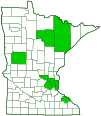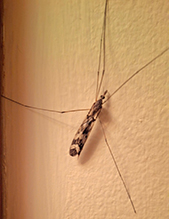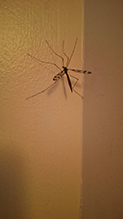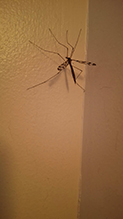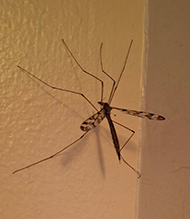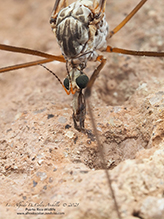Common crane fly
(Tipula trivittata)
Conservation • Description • Habitat • Ecology • Distribution • Taxonomy
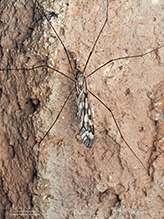
Conservation Status
IUCN Red List
not listed
NatureServe
NNR - Unranked
Minnesota
not listed
Description
Tipula trivittata is a large, early season, common crane fly. It occurs in North America east of the Great Plains, where it is most common in the north and is mostly absent from the south. The larvae feed on decaying vegetation, fungi, roots, foliage, and occasionally animal matter. Adults are active in the spring, from late April to early July. They are found in humid areas with wet ground, often near streams or lakes. They do not feed. They live just a few days, long enough to mate and lay eggs.
Adults are soft-bodied, brown, and 9⁄16″ to ⅞″ (14 to 22 mm) in length.
The head is small. There are two large compound eyes on the sides of the head and no simple eyes (ocelli). The compound eyes are bare, not covered with hairs. The mouth parts are at the end of a short but conspicuous, snout-like projection (rostrum) on the front of the head. At the tip of the rostrum, on the upper side, there is a short, pointed extension (nasus). The lower jaws (maxillae) have long sensory structures (palps) attached. Each palp has four segments. The fourth segment is antennae-like and very long, longer than the first three segments combined. The antennae are short and have 14 segments. The segments are simple, not branched. Each segment has an enlarged base and a whorl of medium-length hairs at the base.
The thorax is slightly humped. The upper thoracic plate (mesonotum) is pale with three dark longitudinal stripes. The middle stripe is pale in the center. There is a distinct, v-shaped groove (suture) on top near the wing bases.
The abdomen is long and slender. Each segment is yellowish-brown with three dark, longitudinal stripes. The lateral margins are gray. The last abdominal segment on the female has a long, acutely pointed, egg-laying apparatus (ovipositor). On the male, the last segment is enlarged into a club-shaped structure (hypopygium) that supports the copulatory apparatus.
The legs are very long and slender. The third segment (femur) on the hind legs is particularly long.
The wings are clear with a distinctive pattern of brown spots.
Size
9⁄16″ to ⅞″ (14 to 22 mm)
Similar Species
Habitat
Humid areas with wet ground, often near streams or lakes
Ecology
Season
Late April to early July
Behavior
Swarms of males fly above a bush or treetop in a mating “dance”. When a male seizes a female, the pair lands on foliage to mate.
Life Cycle
The larvae overwinter in the ground, either frozen or dormant, beneath the frozen soil. When the soil warms in the spring, they become active, finish feeding, and transform into a pupa. The pupal stage lasts one to two weeks, and the adult emerges from the soil. Adults do not feed. They live just long enough to mate and lay eggs, then they die.
Larva Food/Hosts
Decaying vegetation, fungi, roots, foliage, and occasionally animal matter
Adult Food
Adults do not feed
Distribution |
||
|
Sources Biodiversity occurrence data published by: Minnesota Biodiversity Atlas (accessed through the Minnesota Biodiversity Atlas Portal, bellatlas.umn.edu, 12/19/2025). |
|
| 12/19/2025 | ||
Occurrence |
||
|
||
Taxonomy
Order
Suborder
Nematocera
Infraorder
Superfamily
Tipuloidea (Typical Crane Flies)
Family
Subfamily
Genus
Subgenus
Subordinate Taxa
common crane fly (Tipula trivittata laetifica)
common crane fly (Tipula trivittata trivittata) ![]()
Synonyms
Common Names
This species has no common name. The common name of the genus Tipula is common crane flies, and it is applied here for convenience.
Glossary
Mesonotum
The principal exoskeletal plate on the upper (dorsal) part of the middle segment of the thorax of an insect.
Ocellus
Simple eye; an eye with a single lens. Plural: ocelli.
Rostrum
The stiff, beak-like projection of the carapace or prolongation of the head of an insect, crustacean, or cetacean.
Visitor Photos
Share your photo of this insect.
This button not working for you?
Simply email us at info@MinnesotaSeasons.com.
Attach one or more photos and, if you like, a caption.
MinnesotaSeasons.com Photos

Slideshows

Visitor Videos
Share your video of this insect.
This button not working for you?
Simply email us at info@MinnesotaSeasons.com.
Attach a video, a YouTube link, or a cloud storage link.
Other Videos

Sightings
Visitor Sightings
Report a sighting of this insect.
This button not working for you?
Simply email us at info@MinnesotaSeasons.com.
Be sure to include a location.
Minnesota Seasons Sightings
